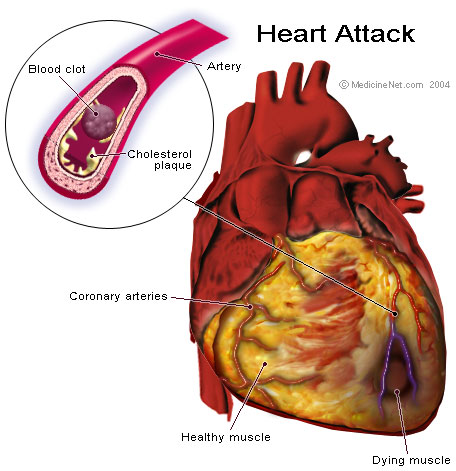Difference Between Ischemia and Infarction
Key Difference – Ischemia vs Infarction
There are vital factors such as oxygen and glucose required by cells for their survival. When these metabolites are not adequately supplied pathological cellular changes start to happen within the cells and if not corrected cellular death ensues. Ischemia and infarction are two such processes that are due to the lack of supply of these vital factors into the cells. Mechanical obstruction of an artery resulting in hypoxia which is the basis for ischemia. An impairment of the venous drainage can also cause ischemic tissue damages. Infarction is the process by which an area of ischemic necrosis is produced either due to an arterial occlusion or an obstruction to the venous drainage. The key difference between ischemia and infarction is necrosis happens only in infarction and not in ischemia.
CONTENTS
1. Overview and Key Difference
2. What is Ischemia
3. What is Infarction
4. Similarities Between Ischemia and Infarction
5. Side by Side Comparison – Ischemia vs Infarction in Tabular Form
6. Summary
What is Ischemia?
Ischemia is the commonest form of cell injury in medicine. Mechanical obstruction of an artery resulting in hypoxia is the basis for ischemia. An impairment of the venous drainage can also cause ischemic tissue damages. Unlike in hypoxia where the energy production can take place via anaerobic respiration, in ischemia the supply of substrates for glycolysis does not happen. Consequently, there is not only an oxygen deficiency but also an energy deficiency. Therefore, there is a rapid cell injury in ischemia than in hypoxia, which is not associated with ischemia.
Mechanism of Ischemia
Due to the lack of oxygen, oxidative phosphorylation does not occur. At the same time, glycolysis is inhibited by the lack of substrates. As a result, there is not enough ATP for the maintenance of cellular ion pumps. This gives rise to an electrolyte imbalance within the cell.
Cellular changes associated with ischemia
- Dispersion of cytoskeleton and the formation of blebs
- Appearance of myelin figures within the cells from the degenerating cellular membranes
- Swelling of mitochondria
- Dilation of ER
These changes are reversible if the hypoxia is corrected within 30-40 minutes from the onset of ischemia.

Figure 01: Ischemia in Lower Limbs
Cell death in ischemia mainly occurs through the activation of apoptotic pathway and necrosis. Cellular organelles progressively degenerate, and there is an efflux of cellular enzymes into the extracellular space. Extracellular macromolecules start entering the cell. Ultimately dead cell masses are replaced by myelin figures which are composed of phospholipids.
What is Infarction?
Infarction is the process by which an area of ischemic necrosis is produced either due to an arterial occlusion or an obstruction to the venous drainage.
Causes of Infarction
- Arterial thrombosis and embolism
- Hemorrhage into an atheromatous plaque
- Compression of an artery by a tumor
- Vascular torsion
- Although venous obstruction can cause infraction, it most often ends up as congestion particularly affecting the vessels with only one efferent vein.
Red Infarcts
Occur with venous occlusion in loose, spongy tissues, in tissues with a double circulation and in tissues that have a congested network of veins.
White Infarcts
These occur due to the arterial occlusion in solid organs with an end arterial supply.
Septic Infarcts
The colonization of microbes in necrosed tissues forms Septic infarcts.
Factors Affecting the Formation of Infarcts
- Anatomy of the vascular supply of the affected region
- Rate of occlusion
- Tissue vulnerability to hypoxia
- hypoxemia

Figure 02: Infarction
Infarctions in almost all the organs of the body except in the brain result in coagulative necrosis. In the brain, infraction gives rise to liquefactive necrosis.
What are the Similarities Between Ischemia and Infarction?
- Tissue damage occurs on both occasions
- Hypoxia is the underlying cause of both ischemia and infarction
What is the Difference Between Ischemia and Infarction?
Ischemia vs Infarction | |
| Ischemia is the commonest form of cell injury in medicine. Mechanical obstruction of an artery resulting in hypoxia is the basis for ischemia. An impairment of the venous drainage can also cause ischemic tissue damages. | Infarction is the process by which an area of ischemic necrosis is produced either due to an arterial occlusion or an obstruction to the venous drainage. |
| Necrosis | |
| Necrosis does not take place. | Necrosis takes place. |
Summary – Ischemia vs Infarction
Ischemia is the commonest form of cell injury in medicine. Mechanical obstruction of an artery resulting in hypoxia is the basis for ischemia. An impairment of the venous drainage can also cause ischemic tissue damages. On the other hand, infarction can be defined as the process by which an area of ischemic necrosis is produced either due to an arterial occlusion or an obstruction to the venous drainage. The difference between these two pathological processes is tissue necrosis occurs only in infarction and not in ischemia.
Download the PDF Version of Ischemia vs Infarction
You can download PDF version of this article and use it for offline purposes as per citation note. Please download PDF version here Difference Between Ischemia and Infarction
Reference:
1.Kumar, Vinay, Stanley Leonard Robbins, Ramzi S. Cotran, Abul K. Abbas, and Nelson Fausto. Robbins and Cotran pathologic basis of disease. 9th ed. Philadelphia, Pa: Elsevier Saunders, 2010. Print.
Image Courtesy:
ncG1vNJzZmivp6x7pbXFn5yrnZ6YsqOx07CcnqZemLyue8OinZ%2Bdopq7pLGMm5ytr5Wau2610pyfnqWZlnqiusNmraxlmaOzor7CraCopl8%3D